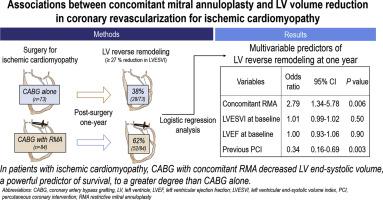The Journal of Thoracic and Cardiovascular Surgery ( IF 4.9 ) Pub Date : 2022-06-02 , DOI: 10.1016/j.jtcvs.2022.04.049 Yusuke Misumi 1 , Satoshi Kainuma 1 , Koichi Toda 1 , Shigeru Miyagawa 1 , Daisuke Yoshioka 1 , Atsushi Hirayama 2 , Tetsuhisa Kitamura 2 , Sho Komukai 3 , Yoshiki Sawa 1 ,

|
Objectives
To elucidate the impact of concomitant restrictive mitral annuloplasty (RMA) on postoperative left ventricular (LV) reverse remodeling and survival in patients with ischemic cardiomyopathy undergoing coronary artery bypass grafting (CABG).
Methods
This study comprised 157 patients with ischemic cardiomyopathy (LV ejection fraction ≤ 40 %) who underwent CABG and completed echocardiographic examination at one year after surgery, with 84 (54%) undergoing concomitant RMA for clinically relevant ischemic mitral regurgitation (MR). The primary endpoint was postoperative reduction in LV end-systolic volume index (LVESVI). The secondary endpoint was overall survival. Median follow-up was 5.1 years.
Results
At baseline, patients who underwent CABG with RMA had a larger LVESVI (83 ± 23 vs. 75 ± 24 mm, P= 0.046). One year postoperatively, CABG with RMA reduced the LVESVI more than did CABG alone (37% vs. 21% from baseline, P<0.001), yielding nearly identical post-operative LVESVI (53 ± 27 vs. 61 ± 26 mm, P= 0.065). In multivariable logistic regression analysis, concomitant RMA was associated with significant LV reverse remodeling (odds ratio 2.79; 95%CI 1.34-5.78; P= 0.006). The prevalence in moderate or severe MR was not different between the groups (7% vs. 10%, P = 0.58). Survival rates were similar between the groups (5-year, 78% vs. 83%, P= 0.35).
Conclusions
In patients with ischemic cardiomyopathy undergoing CABG, concomitant RMA was associated with significant reduction in LVESVI. The impact of LV reverse remodeling on survival remains undetermined.
Word Count232 words
中文翻译:

限制性瓣环成形术对终末期缺血性心肌病患者重构和生存的影响
目标
目的 阐明同步限制性二尖瓣成形术 (RMA) 对接受冠状动脉旁路移植术 (CABG) 的缺血性心肌病患者术后左心室 (LV) 逆转重塑和生存的影响。
方法
该研究纳入了 157 名缺血性心肌病患者(左心室射血分数 ≤ 40%),他们接受了 CABG 并在术后一年完成了超声心动图检查,其中 84 名(54%)患者因临床相关的缺血性二尖瓣反流 (MR) 同时接受了 RMA。主要终点是术后左心室收缩末期容积指数(LVESVI)的减少。次要终点是总生存期。中位随访时间为 5.1 年。
结果
基线时,接受 CABG 联合 RMA 的患者 LVESVI 较大(83 ± 23 比 75 ± 24 mm,P= 0.046)。术后一年,CABG 联合 RMA 比单独 CABG 更能降低 LVESVI(相对于基线分别为 37% 与 21%,P<0.001),术后 LVESVI 几乎相同(53 ± 27 与 61 ± 26 mm,P= 0.065)。在多变量逻辑回归分析中,伴随的 RMA 与显着的 LV 逆重构相关(比值比 2.79;95%CI 1.34-5.78;P=0.006)。各组之间中度或重度 MR 的患病率没有差异(7% 与 10%,P = 0.58)。各组之间的生存率相似(5 年生存率,78% vs. 83%,P = 0.35)。
结论
在接受 CABG 的缺血性心肌病患者中,伴随 RMA 与 LVESVI 显着降低相关。左室逆重塑对生存的影响仍不确定。
字数232字











































 京公网安备 11010802027423号
京公网安备 11010802027423号